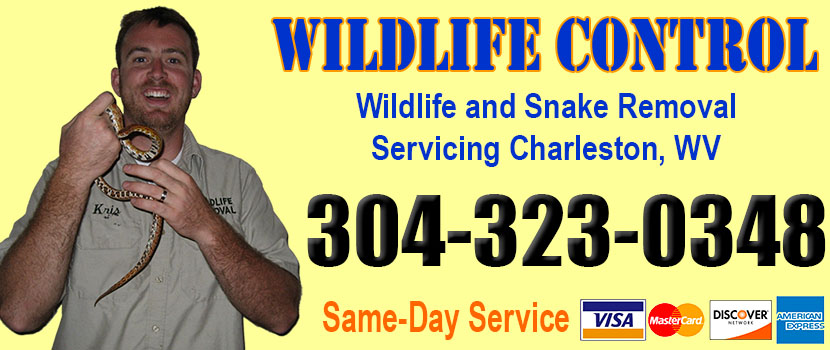
Welcome to charlestonwvsnakes.com! I am David, a snake enthusiast living in Charleston, WV. Many people don't know that Charleston is in fact full of snakes! You just need to know where to find them - they can often be shy and elusive. Some West Virginia snake species are more common outside of the city limits, in different parts of Kanawah County WV, but many types of snakes are indeed common in the more urban parts of Charleston. This guide is meant to help educate you about the beautiful snakes of Charleston, and to help you identify the most common snakes of Charleston, as well as the venomous snakes of Charleston that you should learn to recognize and avoid. If you want more detail, click here for my complete list of ALL snake species in Charleston. Remember the following:
- Most snakes of Charleston are harmless and don't want to encounter you
- Venomous snakes exist but are uncommon in Charleston, West Virginia
- Snakes eat rats and mice and are a valuable part of the West Virginia ecosystem
- Never kill a snake - if you leave a snake alone, it will leave you alone.
Common Snake Species in Charleston
 Queen snake:
The queen snake is a slender snake that can grow as long as three feet. They are aquatic snakes that are blackish or grayish in color. They have distinct physical features such as the yellowish stripes that are on the lower back of their bodies.
Queen snakes also have yellow bellies adorned with black stripes. They are found close to water bodies like rivers and small, rocky creeks. Queen snakes have strongly keeled scales, and their diet includes different small aquatic animals, including crayfish.
Queen snake:
The queen snake is a slender snake that can grow as long as three feet. They are aquatic snakes that are blackish or grayish in color. They have distinct physical features such as the yellowish stripes that are on the lower back of their bodies.
Queen snakes also have yellow bellies adorned with black stripes. They are found close to water bodies like rivers and small, rocky creeks. Queen snakes have strongly keeled scales, and their diet includes different small aquatic animals, including crayfish.
 Northern brown snake:
Northern brown snakes are small snakes found mostly in moist woodlands. The snakes can grow up to 20 inches in length. The northern brown snake can be identified by physical features such as the two rows of black dots that are found on their back. They also have 17 rows of keeled scales. The diet of the snakes includes different small invertebrates. They feed on slugs, insects, and earthworms.
Northern brown snake:
Northern brown snakes are small snakes found mostly in moist woodlands. The snakes can grow up to 20 inches in length. The northern brown snake can be identified by physical features such as the two rows of black dots that are found on their back. They also have 17 rows of keeled scales. The diet of the snakes includes different small invertebrates. They feed on slugs, insects, and earthworms. 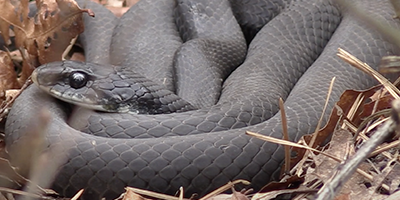 Northern black racers:
The northern black racer is one of the commonest non-venomous snakes found in Charleston, West Virginia. They are known for the speed at which they move, particularly when they are provoked. The snakes can be particularly aggressive when they are attacked.
These snakes have smooth scales and are black in color. The common habitats of the northern black racers are basements and old barns. They enter these habitats in search of their food which can be rats and small reptiles.
Distinct physical features of the northern black racer are the black color and the white throat patch.
Northern black racers:
The northern black racer is one of the commonest non-venomous snakes found in Charleston, West Virginia. They are known for the speed at which they move, particularly when they are provoked. The snakes can be particularly aggressive when they are attacked.
These snakes have smooth scales and are black in color. The common habitats of the northern black racers are basements and old barns. They enter these habitats in search of their food which can be rats and small reptiles.
Distinct physical features of the northern black racer are the black color and the white throat patch.
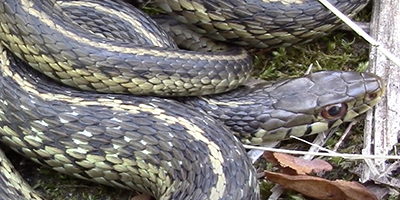 Eastern garter snake:
These snakes make their habitats out of different environments and are commonly encountered. The eastern garter snake can live in buildings, marshes, hillsides, and building lots. The color of the snakes also varies. They can be brownish, grayish, or greenish.
Eastern garters can grow as long as four feet. They feed on small animals and can be attracted to an area because of the presence of small animals like rodents.
Eastern garter snake:
These snakes make their habitats out of different environments and are commonly encountered. The eastern garter snake can live in buildings, marshes, hillsides, and building lots. The color of the snakes also varies. They can be brownish, grayish, or greenish.
Eastern garters can grow as long as four feet. They feed on small animals and can be attracted to an area because of the presence of small animals like rodents.
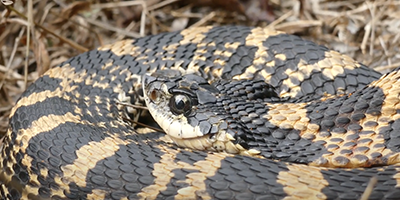 Eastern hognose snake:
The eastern hognose snake is known for the unique behavior it displays when it is threatened. The snake inflates its body with air and flattens its neck and head as a defensive position when hissing and striking at a predator.
Eastern hognose snakes get their name from their upturned short and flat snout which can be likened to a pig’s nose. These snakes can also play dead when they feel threatened. They simply roll over and play dead like an opossum.
Eastern hognose snake:
The eastern hognose snake is known for the unique behavior it displays when it is threatened. The snake inflates its body with air and flattens its neck and head as a defensive position when hissing and striking at a predator.
Eastern hognose snakes get their name from their upturned short and flat snout which can be likened to a pig’s nose. These snakes can also play dead when they feel threatened. They simply roll over and play dead like an opossum.
Venomous Snake Species in Charleston
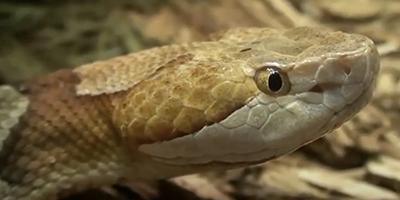 Northern copperhead:
This venomous snake is found in different parts of West Virginia, including Charleston. The snake has characteristic features such as the copper color of its head. The northern copperhead is one of the two venomous snakes of West Virginia.
Northern copperheads are most commonly found in the woods. The snakes are not known to be aggressive. Even though they prefer to be left alone, northern copperheads can strike at predators or intruders from a distance and release venom in their bites. Copperheads do not rattle but they can be identified based on their characteristic physical features. The hourglass-shaped crossbands on the back of the snakes is a noteworthy distinguishing feature.
Northern copperhead:
This venomous snake is found in different parts of West Virginia, including Charleston. The snake has characteristic features such as the copper color of its head. The northern copperhead is one of the two venomous snakes of West Virginia.
Northern copperheads are most commonly found in the woods. The snakes are not known to be aggressive. Even though they prefer to be left alone, northern copperheads can strike at predators or intruders from a distance and release venom in their bites. Copperheads do not rattle but they can be identified based on their characteristic physical features. The hourglass-shaped crossbands on the back of the snakes is a noteworthy distinguishing feature.
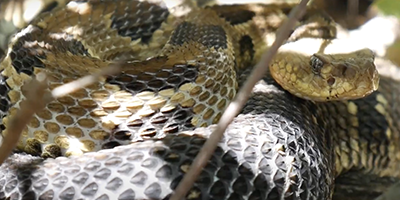 Timber rattlesnakes:
Timber rattlesnakes are encountered in Charleston, West Virginia, particularly in high mountainous areas. The rattling sounds of the snakes can be used to identify them. The snakes can grow as long as four feet. They have two color phases, the yellow and black phases. The phase of the rattlesnake determines its color as it can be golden yellow or black.
In West Virginia, the snakes are mostly found in higher elevations. The bites of the rattlesnakes are severe, as the venom is more potent than that of copperheads.
Timber rattlesnakes:
Timber rattlesnakes are encountered in Charleston, West Virginia, particularly in high mountainous areas. The rattling sounds of the snakes can be used to identify them. The snakes can grow as long as four feet. They have two color phases, the yellow and black phases. The phase of the rattlesnake determines its color as it can be golden yellow or black.
In West Virginia, the snakes are mostly found in higher elevations. The bites of the rattlesnakes are severe, as the venom is more potent than that of copperheads.
If you're unsure, you can email me a photo of the snake at info@charlestonwvsnakes.com and I will email you back with the snake's species. If you found a snake skin, read my Found a Skin? page, and you can email me a photo of the skin, and I'll identify the snake for you. If you need professional Charleston snake removal help, click my Get Help page, or see the below website sponsor I found, who provides that service.
Can I get the city or animal services to help me remove a snake?
Will the City Remove Snake Problems?
Snakes are a threat to you and your property. Whether venomous or not, you have to worry about the chance of them biting you or others. You cannot let them roam freely. You must take action immediately to remove the snake from your property, before anything goes wrong for you. There are a few ways to go about this, but many prefer the easiest option – getting someone else to do it. With animal services available in most areas, this is the common option. Animal services does seem perfect on paper. These are professionals whose job is to remove animals from properties. They should do the job, but will they? Are they going to help you, or are you wasting your time trying to get them to help?
Animal Services
Rarely will animal services be of any help. Generally, they are for pet-related issues, not pest or wildlife issues. Any pest- or wildlife-related problem you have is beyond their control. Animal control services do not receive training, equipment, or knowledge related to the removal of pest or wildlife. They are not equipped with anything to remove them. In most cases, they are going to outright deny going to your property. Frustrating as it may be, this is not something they can handle. It is not part of their job description, nor is it something they could do in general. You need specialist knowledge, tools, and skills to handle snakes.
What You Can Do
When you have a snake on your property, there are two options. If you do not want to do it yourself at all, you can contact a professional. There are services, that require payment, that will remove the snake for you. These services can, oftentimes, do the trick. Another option is to remove the snake yourself. Traps and exclusion methods can do this for you. Both work exceptionally well for removal and are easy to implement. They are low risk and high reward. What you do should depend on the situation. Professionals are a necessity for venomous snakes, while you can manage it on your own with the non-venomous kinds. So long as you stay safe, you can handle this task. There are ways to remove snakes from your property, but animal control services is not one of them. These services are not going to assist you with the removal at any point and are not able to do anything for you.
Remember, the term is not poisonous snakes of Charleston, it's venomous snakes of Charleston. Poison is generally something you eat, and venom is injected into you. That said, dangerous snakes are very rare in Charleston. The few venomous snakes of Kanawah County are rarely seen. But they are commonly misidentified, so learn about all the snake species of Charleston in order to correctly identify them. These snakes are usually also found in the surrounding towns of Charleston, South Charleston, Saint Albans, Cross Lanes, Elkview, Dunbar, Sissonville, Clendenin, Belle, Cedar Grove, Marmet, East Bank, Chesapeake, Pratt, Tornado, Glasgow, Chelyan, Jefferson, Pinch, Handley, Coal Fork, Big Chimney, Hugheston, Dawes, Shrewsbury, and the surrounding areas.
Read our article about:
Understanding The Black Racer Snake: Appearance, Biology, Life Cycle, Habitat, Diet, Behavior
charlestonwvsnakes.com domain and hosting costs made possible by the generous support of this sponsor:
